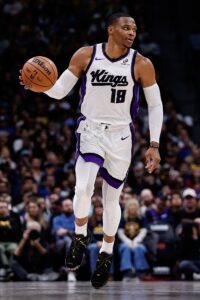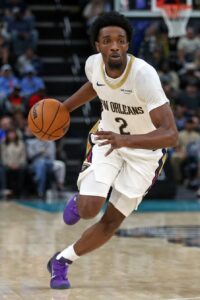In a pair of previous articles, we took a closer look at the trade restrictions placed on two groups of players who signed free agent contracts this past offseason. The smaller of the two groups featured players who can’t be traded by their current teams until January 15, having re-signed on contracts that met a set of specific criteria. The other offseason signees we examined aren’t eligible to be traded until December 15.
In addition to those two groups, there are a few other subsets of players who face certain trade restrictions this season. They either can’t be traded until a certain date, can’t be traded in certain packages, or can’t be traded at all prior to February’s deadline.
Listed below are the players affected by these trade restrictions. This list, which we’ll continue to update throughout the season as needed, can be found on our desktop sidebar under “Hoops Rumors Features,” or in our mobile menu under “Features.”
Players who recently signed as free agents or had their two-way contracts converted:
A player who signs a free agent contract typically becomes trade-eligible either three months after he signs or on December 15, whichever comes later. That means a player who signs on September 10 would become trade-eligible on Dec. 15, but one who signs on Sept. 22 wouldn’t be eligible to be dealt until Dec. 22.
Similarly, players who have two-way pacts converted to standard contracts can’t be dealt for three months after that happens.
Here are the affected players, who signed free agent contracts or were converted from two-way deals after Sept. 15, along with the dates their trade restrictions lift:
December 25:
- Thomas Bryant (Cavaliers)
December 29:
- Gary Payton II (Warriors)
January 1:
- Al Horford (Warriors)
- De’Anthony Melton (Warriors)
January 16:
- Russell Westbrook (Kings)
January 18:
- Keaton Wallace (Hawks)
January 23:
- DeAndre Jordan (Pelicans)
February 4:
- Precious Achiuwa (Kings)
Players who sign free agent contracts or have their two-way deals converted to standard contracts after November 5 this season won’t become trade-eligible prior to the 2026 trade deadline, which falls on February 5. That restriction applies to the following players, listed in alphabetical order:
- Jeremiah Robinson-Earl (Pacers)
Players who recently signed veteran contract extensions:
A player who signs a veteran contract extension can’t be dealt for six months if his new deal exceeds the NBA’s extend-and-trade limits by meeting any of the following criteria:
- Includes a first-year raise greater than 20% (or greater than 20% of the estimated average salary, for players earning below that average).
- Includes a subsequent annual raise greater than 5%.
- Includes a renegotiation of the player’s current salary.
- Secures the player for more than four total seasons (including both his current deal and the extension).
A player can sign a veteran extension and remain trade-eligible as long as his new deal doesn’t meet any of those criteria. Mavericks big man Daniel Gafford, for instance, remained eligible to be traded after signing a three-year extension that featured a 20% raise for the first year and 5% raises in the second and third years.
Kevin Durant‘s two-year extension with the Rockets falls into this boat too, since he accepted a pay cut in year one and a 5% raise in year two.
Here are the players whose recent veteran extensions exceed the extend-and-trade limits, along with the dates their trade restrictions lift:
December 14:
- Steven Adams (Rockets)
December 29:
- Jaylin Williams (Thunder)
January 7:
- Jakob Poeltl (Raptors)
January 10:
- Devin Booker (Suns)
January 13:
- Jaren Jackson Jr. (Grizzlies)
January 14:
- Herbert Jones (Pelicans)
February 1:
- Mikal Bridges (Knicks)
February 2:
- Luka Doncic (Lakers)
February 4:
- De’Aaron Fox (Spurs)
Ineligible to be traded before this season’s February 5 deadline:
- Toumani Camara (Trail Blazers)
- A.J. Green (Bucks)
- Aaron Nesmith (Pacers)
- P.J. Washington (Mavericks)
Additionally, when a player signs a super-max contract extension, he becomes ineligible to be traded for one full year.
That means Thunder guard Shai Gilgeous-Alexander won’t become trade-eligible prior to the 2026 deadline despite signing his extension in July. Gilgeous-Alexander is the only player who signed a super-max (designated veteran) contract this summer.
Players who were recently claimed off waivers:
A player who is claimed off waivers is ineligible to be traded for 30 days. When a waiver claim occurs during the offseason, the 30-day clock begins on the first day of the subsequent season.
As our tracker shows, two waiver claims have occurred so far during the 2025/26 league year, with one happening in July – the Suns claiming Jordan Goodwin – and one earlier this month, when the Pistons claimed Isaac Jones.
Goodwin became eligible to be dealt this week, as Thursday marked the 30-day point of the season. Jones, who was claimed by Detroit on November 6, will become trade-eligible on December 6.
Players who were recently traded:
Players who were recently traded can be flipped again immediately. However, unless they were acquired via cap room, they can’t be traded again immediately in a deal that aggregates their salary with another player’s for matching purposes. There’s a two-month restriction on making that sort of move.
However, as our offseason trade tracker shows, no deals have been completed since September 16, which was more than two months ago. So this aggregation restriction doesn’t currently apply to any players.
Any player who is traded after December 16 (without being acquired via cap room) won’t be eligible to be flipped before the trade deadline in a second deal that aggregates his salary with another player’s. A special exception allows a player acquired between Dec. 5 and Dec. 16 to be “re-aggregated” beginning on Feb. 4, a little ahead of the typical two-month waiting period.
Note: Only players on standard, full-season contracts are listed on this page. Players who sign 10-day contracts can’t be traded. Players who sign two-way deals can’t be traded for up to 30 days after signing.